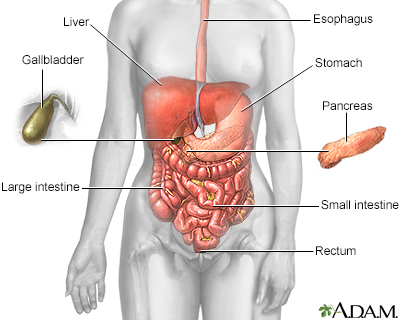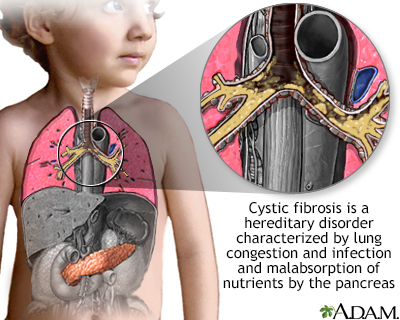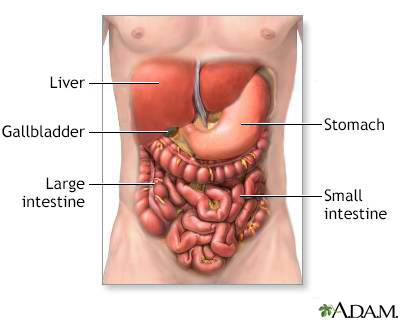Malabsorption
Definition
Malabsorption involves problems with the body's ability to take in (absorb) nutrients from food.
Causes
Many diseases can cause malabsorption. Most often, malabsorption involves problems absorbing certain sugars, fats, proteins, or vitamins. It can also involve an overall problem with absorbing food.
Problems or damage to the small intestine that may lead to problems absorbing important nutrients. These include:
- Celiac disease
- Tropical sprue
- Crohn disease
- Whipple disease
- Damage from radiation treatments
- Overgrowth of bacteria in the small bowel
- Parasite or tapeworm infection
- Surgery that removes all or part of the small intestine
Enzymes produced by the pancreas help absorb fats and other nutrients. A decrease of these enzymes makes it harder to absorb fats and certain nutrients. Problems with the pancreas may be caused by:
- Cystic fibrosis
- Infections or swelling of the pancreas
- Trauma to the pancreas
- Surgery to remove part of the pancreas
Some of the other causes of malabsorption include:
- AIDS and HIV
- Certain medicines (tetracycline, some antacids, some medicines used to treat obesity, colchicine, acarbose, phenytoin, cholestyramine)
- Gastrectomy and surgical treatments for obesity
- Cholestasis
- Chronic liver disease
- Cow's milk protein intolerance
- Soy milk protein intolerance
Symptoms
In children, current weight or rate of weight gain is often much lower than that of other children of similar age and sex. This is called failure to thrive. The child may not grow and develop normally.
Adults may also have failure to thrive, with weight loss, muscle wasting, weakness, and even problems thinking.
Changes in the stools are often present, but not always.
Changes in the stools may include:
- Bloating, cramping, and gas
- Bulky stools
- Chronic diarrhea
- Fatty stools (steatorrhea)
Exams and Tests
Your health care provider will do an exam. Tests that may be done include:
- Blood and urine tests
- CT scan of the abdomen
- Hydrogen breath test
- MR or CT enterography
- Schilling test for vitamin B12 deficiency
- Secretin stimulation test
- Small bowel biopsy
- Stool culture or culture of small intestine aspirate
- Stool fat testing
- X-rays of the small bowel or other imaging tests
Treatment
Treatment depends on the cause and is aimed at relieving symptoms and ensuring the body receives enough nutrients.
A high-calorie diet may be tried. It should supply:
- Key vitamins and minerals, such as iron, folic acid, and vitamin B12
- Enough carbohydrates, proteins, and fats
If needed, injections of some vitamins and minerals or special growth factors will be given. Those with damage to the pancreas may need to take pancreatic enzymes. Your provider will prescribe these if necessary.
Medicines to slow down the normal movement of the intestine can be tried. This may allow food to remain in the intestine longer.
If the body is not able to absorb enough nutrients, total parenteral nutrition (TPN) is tried. It will help you or your child get nutrition from a special formula through a vein in the body. Your provider will select the right amount of calories and TPN solution. Sometimes, you can also eat and drink while getting nutrition from TPN.
Outlook (Prognosis)
The outlook depends on what is causing the malabsorption.
Possible Complications
Long-term malabsorption can result in:
When to Contact a Medical Professional
Contact your provider if you have symptoms of malabsorption.
Prevention
Prevention depends on the condition causing malabsorption.
Gallery



References
Högenauer C, Hammer HF. Maldigestion and malabsorption. In: Feldman M, Friedman LS, Brandt LJ, eds. Sleisenger and Fordtran's Gastrointestinal and Liver Disease. 11th ed. Philadelphia, PA: Elsevier; 2021:chap 104.
Semrad CE. Approach to the patient with diarrhea and malabsorption. In: Goldman L, Schafer AI, eds. Goldman-Cecil Medicine. 26th ed. Philadelphia, PA: Elsevier; 2020:chap 131.